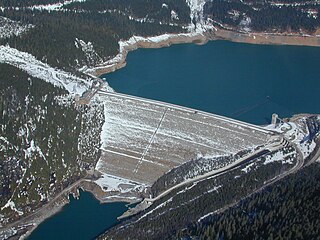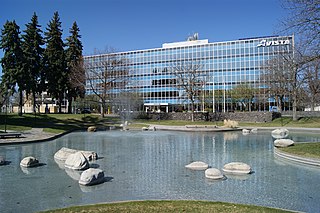The British Columbia Hydro and Power Authority, operating as BC Hydro, is a Canadian electric utility in the province of British Columbia. It is the main electricity distributor, serving more than 4 million customers in most areas, with the exception of the City of New Westminster, where the city runs its own electrical department and portions of the West Kootenay, Okanagan, the Boundary Country and Similkameen regions, where FortisBC, a subsidiary of Fortis Inc. directly provides electric service to 213,000 customers and supplies municipally owned utilities in the same area. As a provincial Crown corporation, BC Hydro reports to the BC Ministry of Energy, Mines and Low Carbon Innovation, and is regulated by the British Columbia Utilities Commission (BCUC). Its mandate is to generate, purchase, distribute and sell electricity.

Mica Dam is a hydroelectric embankment dam spanning the Columbia River 135 kilometres north of Revelstoke, British Columbia, Canada. It was built as one of three Canadian projects under the terms of the 1964 Columbia River Treaty and is operated by BC Hydro. Completed in 1973, the Mica powerhouse had an original generating capacity of 1,805 megawatts (MW). Mica Dam, named after the nearby settlement of Mica Creek and its associated stream, in turn named after the abundance of mica minerals in the area, is one of the largest earthfill dams in the world. The reservoir created by the dam is Kinbasket Lake. Water from the dam flows south directly into Revelstoke Lake, the reservoir for the Revelstoke Dam. Mica Dam is the tallest dam in Canada and second tallest in North America after the Chicoasén Dam in Mexico and it is the farthest upstream dam on the Columbia River. The dam's underground powerhouse was the second largest in the world at the time of its construction, and was the first 500 kV installation of sulphur hexafluoride (SF6) insulated switchgear in the world.

Hugh Keenleyside Dam is a flood control dam spanning the Columbia River, 12 km upstream of the city of Castlegar, British Columbia, Canada.
The Columbia River Treaty is a 1961 agreement between Canada and the United States on the development and operation of dams in the upper Columbia River basin for power and flood control benefits in both countries. Four dams were constructed under this treaty: three in the Canadian province of British Columbia and one in the U.S. state of Montana.

The electricity sector in Canada has played a significant role in the economic and political life of the country since the late 19th century. The sector is organized along provincial and territorial lines. In a majority of provinces, large government-owned integrated public utilities play a leading role in the generation, transmission, and distribution of electricity. Ontario and Alberta have created electricity markets in the last decade to increase investment and competition in this sector of the economy.
John Sylvester Weisgerber was a Canadian politician and businessman. He was a member of the Legislative Assembly in British Columbia. During his political career he was briefly the leader of the British Columbia Social Credit Party and the Reform Party of British Columbia. After leaving politics, he was appointed to the board of BC Hydro in 2001 and served as a member of the British Columbia Treaty Commission.

Park Place is a signature skyscraper located at 666 Burrard Street in Downtown Vancouver's Financial District. Park Place has 35 storeys, and was completed in 1984. It stands at 140 m (459 ft) and is one of the tallest buildings in the city. It is currently managed by Quadreal Property Group.

The Homathko River is one of the major rivers of the southern Coast Mountains of the Canadian province of British Columbia. It is one of the few rivers that penetrates the range from the interior Chilcotin Country to the coastal inlets of the Pacific Ocean. The Homathko River reaches the sea at the head of Bute Inlet, just west of the mouth of the Southgate River.
The British Columbia Transmission Corporation (BCTC) was a Crown corporation in the province of British Columbia, Canada that existed from 2003 to 2010. BCTC's mandate was to plan, build, operate and maintain B.C.'s electrical transmission network.

Canada has access to all main sources of energy including oil and gas, coal, hydropower, biomass, solar, geothermal, wind, marine and nuclear. It is the world's second largest producer of uranium, third largest producer of hydro-electricity, fourth largest natural gas producer, and the fifth largest producer of crude oil. In 2006, only Russia, the People's Republic of China, the United States and Saudi Arabia produce more total energy than Canada.
FortisBC is a British Columbia based regulated utility that provides natural gas and electricity. FortisBC has approximately 2,600 employees serving more than 1.2 million customers in 135 B.C. communities and 58 First Nations communities across 150 Traditional Territories.

The Jordan River Dam, officially the Jordan River Diversion Dam, and known locally simply as Diversion Dam, is a dam located in Jordan River, British Columbia, Canada. It is part of the second hydroelectric development on Vancouver Island.
According to the International Hydropower Association, Canada is the fourth largest producer of hydroelectricity in the world in 2021 after the United States, Brazil, and China. In 2019, Canada produced 632.2 TWh of electricity with 60% of energy coming from Hydroelectric and Tidal Energy Sources).

The Site C Dam is a hydroelectric dam currently under construction on the Peace River, 14 kilometers southwest of Fort St. John in northeastern British Columbia, Canada. It is located approximately 80 kilometers downstream from the W. A. C. Bennett Dam. When completed in 2025, it will become the fourth largest producer of hydroelectricity in British Columbia, with an expected capacity of 1,100 MW and an expected annual output of 4,600 GWh of electricity.

Alterra Power Corp. a subsidiary of Innergex Renewable Energy Inc., is a diversified renewable power generation company based in Vancouver, British Columbia, Canada. It was formed in 2011 through the merger of Magma Energy Corp. and Plutonic Power Corp. It develops, owns, acquires and operates hydroelectric, wind, solar energy and geothermal projects. On February 6, 2018, Innergex Renewable Energy Inc. completed the acquisition of Alterra including all its assets.

Avista Corporation is an American energy company which generates and transmits electricity and distributes natural gas to residential, commercial, and industrial customers. Approximately 1,550 employees provide electricity, natural gas, and other energy services to 359,000 electric and 320,000 natural gas customers in three western states. The service territory covers 30,000 square miles (78,000 km2) in eastern Washington, northern Idaho, and parts of southern and eastern Oregon, with a population of 1.5 million.

Run of River Power or ROR Power is a Canadian based energy company. Its business in the renewable energy sector, creating sustainable energy through its portfolio of run-of-river and biomass projects in British Columbia.
Innergex Renewable Energy Inc. is a developer, owner and operator of run-of-river hydroelectric facilities, wind energy, and solar farms in North America, France and South America. While many of the firm's operational assets are located in its home province of Québec, it has expanded into Ontario, British Columbia, and Idaho, as well as Chile and France
The Kemano Generating Station is situated 75 km (47 mi) southeast of Kitimat in the province of British Columbia, Canada. It was completed in 1954, providing hydroelectricity for Alcan's Kitimat Aluminum smelter. The powerhouse is built in a cavern created 427 m (1,400 ft) inside the base of Mt Dubose. It produces 896 MW of power from its eight generator units, each of which has a capacity of 112 MW. It was the largest producer in the province when it was built, and is now the fifth largest electrical plant in British Columbia.










